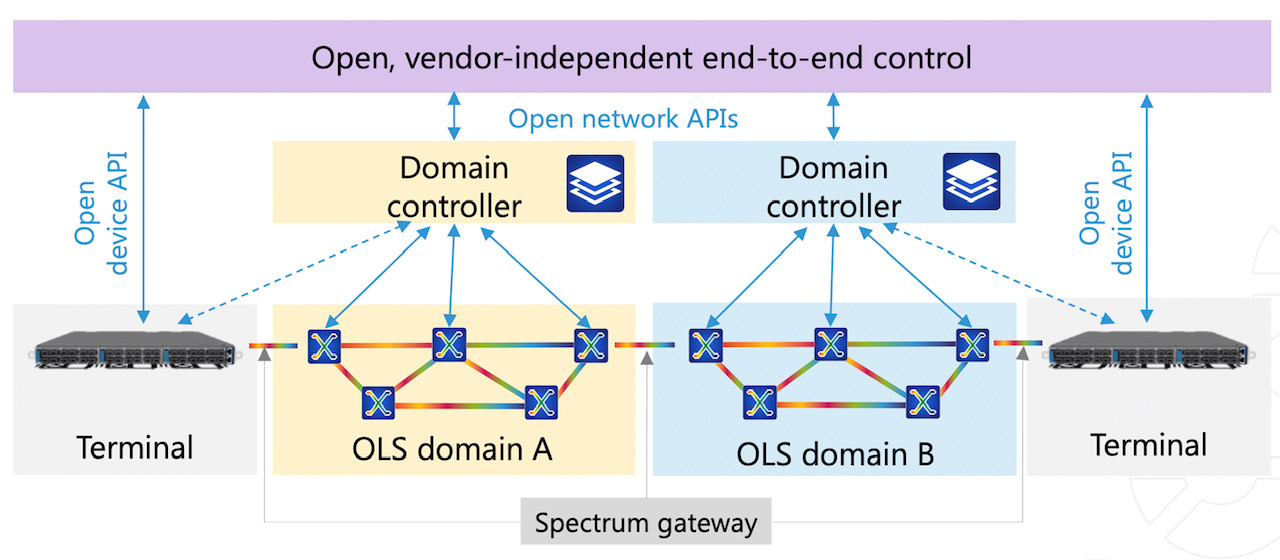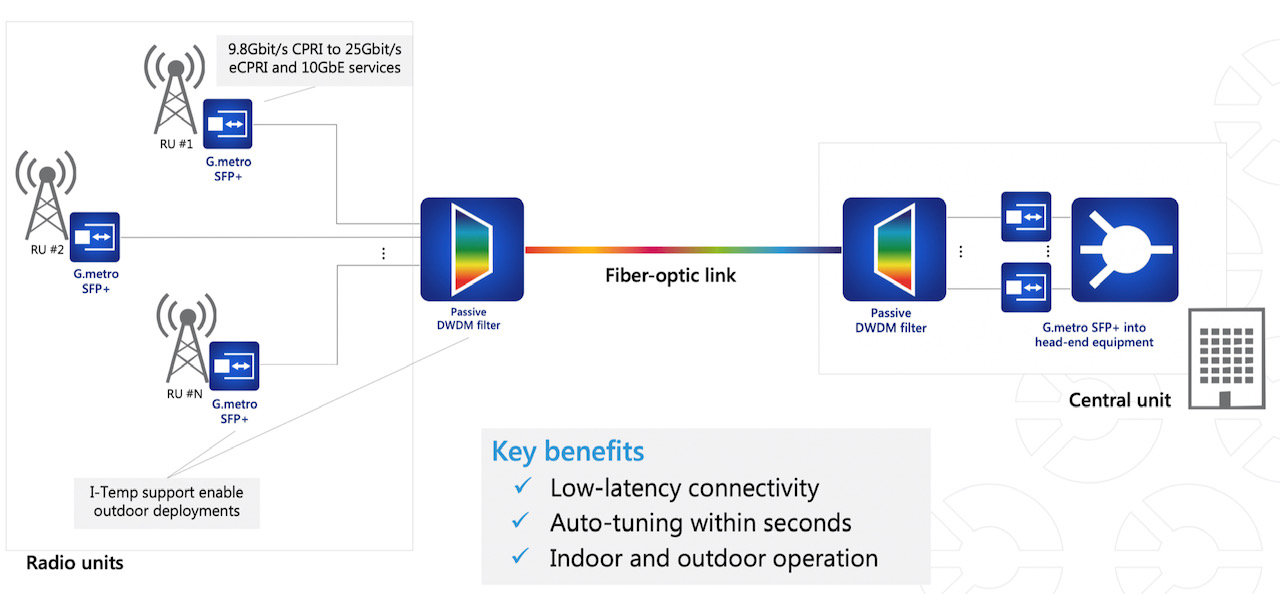ADVA enables the sharing of spectrum at the optical layer
 Monday, June 22, 2020 at 3:50PM
Monday, June 22, 2020 at 3:50PM • Spectrum-as-a-service enables third parties to run networks over existing optical infrastructure.
• ADVA has also simplified linking systems to the metro-access network using self-tuning SFP+ optical modules.
ADVA has developed a scheme whereby communications service providers can sell unused fibre capacity to customers to design and run their own optical networks.
“Optical spectrum-as-a-service gives communications service providers tools to sell spectrum to someone else who now doesn’t need to build a parallel infrastructure,” says Jörg-Peter Elbers, ADVA’s senior vice president, advanced technology, standards and IPR.
 Jörg-Peter Elbers
Jörg-Peter Elbers
ADVA has also developed a G.metro-compliant dense wavelength-division multiplexing (DWDM) scheme to simplify linking business parks, radio cell towers and small cells to a metro-access network.
The G.metro scheme uses a self-tuning pluggable SFP+ module that sets up connections to the network’s end-points.
ADVA says the connectivity scheme is timely given how mobile sites need 10-gigabit and in future 25-gigabit connections while business services are now at 10 gigabits.
“Premium business services at one gigabit made using DWDM hard to justify,” says Elbers. “At 10-gigabit links, the argument for DWDM is easier to make since the overall capacity is much higher.”
Optical spectrum-as-a-service
Communications service providers often start deployments with as few as two wavelengths. Yet they must pay upfront the cost of common infrastructure such as the optical amplifiers and reconfigurable optical add-drop multiplexers (ROADMs).
“When they deploy, they can’t amortise this cost over many [optical] channels,” says Elbers.
Spectrum-as-a-service offers new revenue for operators while sparing the end-customer from having to build their own optical infrastructure.
Spectrum-sharing builds on the existing practice of running an alien wavelength from a third-party over an optical line system. Instead of channels, operators now sell spectrum to a customer who can then design their optical network for their high-capacity traffic.
Implementation
Hardware and software elements are needed to implement spectrum sharing.
The hardware includes the line system’s amplifiers and flexible-grid ROADMs that are used to slice the spectrum into blocks.
“If you want to segment the spectrum arbitrarily, which is where most of the value is, you need to have flexgrid technology,” says Elbers.
ADVA also includes spectrum gateway and demarcation functions that isolate the tenants’ traffic and ensures that wavelengths introduced by each tenant is confined to their assigned spectrum.
The customer also needs to monitor the optical layer to plan and control their allocated spectrum services. The ADVA software includes a software-defined networking (SDN) controller and the ability to access performance information.
“This is where an SDN controller comes in handy,” says Elbers. “It is a gating point where you can decide who is allowed to do what and who controls which resources, so you don’t get conflicts and unwanted side-effects.” The controller enables the operator to expose the infrastructure for the tenants (see diagram).
 Source: ADVA
Source: ADVA
Elbers says these capabilities will be introduced gradually. Initially, a customer can tell the operator what to implement but the end-goal is to enable the tenant to design, implement and control their optical network.
Spectrum-as-a-service has become possible due to the maturity of the technologies. Coherent interfaces simplify network planning given their predictable performance while flexible-grid ROADMs enable spectrum slicing and changing the channel widths in a slice to accommodate new symbol rates over time.
 Stephan Rettenberger
Stephan Rettenberger
“This is a new decoupling of the optical line system from the terminals,” says Stephan Rettenberger, senior vice president, marketing and investor relations at ADVA. “Given fibre is a precious material, this is the way the industry needs to move and we’ve made progress in the line system to empower this.”
Metro-access applications
ADVA has also announced a metro-access connectivity scheme where fibre is scarce. For such applications, using a dedicated fibre to carry a single 1, 10 or 25-gigabit wavelength is wasteful.
Example networking applications include front-haul and back-haul for mobile, and business services.
The G.metro-complaint solution simplifies the equipment required. “All that is needed is to transport signals over fibre and do it with the lowest latency,” says Elbers.
For wireless, the SFP+ is simply plugged in at the remote-radio head. All the issues of optical tuning are hidden from the user and taken care of by the module communicating with the head-end.
The same applies to 10-gigabit premium services to connect business parks. Enterprises are connected on a pay-as-you-grow basis by deploying passive optical filtering. “You don’t need any active equipment in the field and everything is controlled at the end-point,” says Elbers.
The end-point equipment used for mobile is different from that used by enterprises. In turn, each application has its preferences, he says: “This is where pluggable modules come into play, irrespective of what the host equipment is, you just plug in the appropriate SFP+ module.”
Self-configuring links
The SFP+ modules’ span 10 to 20km links although 40-80km could be used if needed.
 Source: ADVA
Source: ADVA
The wavelength counts used are commonly fewer than in metro networks. Elbers cites as an example 12 wavelengths to carry common public radio interface (CPRI) traffic from a mobile tri-sector radio mast where each sector uses four frequency bands. “But, in principle, it is not limited to any wavelength count,” he says.
Filters are used at the head-end and the end-points. Plugging in an SFP+, the local filter determines which wavelength is used. The SFP+ tunes itself to the required wavelength while the filter ensures separation from the other signals on the fibre.
ADVA uses an in-band communication channel to relay the status information of the remote signal. The optical layer in-band scheme is independent of the protocols run on the fibre, ensuring its workings whatever the end-equipment used.
ADVA is working with several transceiver partners to develop the SFP+ and is using its intellectual property (IP). The company’s IP includes the wavelength control and the information sharing between the end-points.
The G.metro solution is now generally available.



Reader Comments